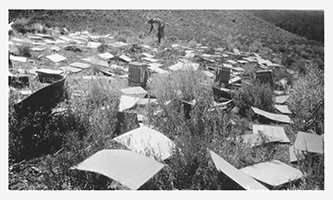News
Celebrating Women’s History Month
4 March 2024
We're kicking off Women's History Month with a group project, featuring two men, three women and the Newe (or Shoshone) of Nevada. Together their work gave a generation of women the freedom of choice to make history on their own terms.
In 1937 William Andrew Archer (1894–1973) became director of the Nevada Indian Medicine Project. The project recorded the medicinal uses of plants by the indigenous people of Nevada, collected herbarium specimens and sent plant material to the University of Minnesota for pharmaceutical analysis. While Agnes Hume Scott Train (later Janssen, 1905–1991) acted as interpreter, Percy Train (1876–1942) collected Lithospermum ruderale Douglas ex Lehmann and interviewed the usually male elders of the Newe. However, with Edith Van Allen Murphey (1879–1968), the Newe women were more forthcoming, graciously sharing their medicinal uses of the plant, one of which was as a contraceptive. At the University of Minnesota Elizabeth Morrison Cranston's 1944 dissertation studied the effects of L. ruderale on the reproductive cycle of mice. After further research L. ruderale became an important ingredient in the birth control pill.
The findings of this project were summarized in Train, Henrichs and Archer, Medicinal Uses of Plants by Indian Tribes of Nevada (1941, Contr. Fl. Nevada 33). To read the report and the interviews, see our Archer collection. Please note that the items do reflect the time period's attitudes toward Indigenous Americans.
Follow us on the former Twitter and on Facebook or check out the rotating featured items on the homepage of our Web site as we spend the month adventuring through botanical history with the women in our collections.
About the Hunt Institute for Botanical Documentation
The Hunt Institute for Botanical Documentation, a research division of Carnegie Mellon University, specializes in the history of botany and all aspects of plant science and serves the international scientific community through research and documentation. To this end, the Institute acquires and maintains authoritative collections of books, plant images, manuscripts, portraits and data files, and provides publications and other modes of information service. The Institute meets the reference needs of botanists, biologists, historians, conservationists, librarians, bibliographers and the public at large, especially those concerned with any aspect of the North American flora.
Media Contact:
Scarlett T. Townsend
412-268-7304
st19@andrew.cmu.edu
![<p>Lithospermum ruderale [<em>Lithospermum ruderale</em> Douglas ex Lehmann, Boraginaceae] entry, Nevada Indian drug plant data, volume 4, 1937–1940, HI Archives William Andrew Archer collection no. 3.</p>](/admin/uploads/02lithospermum-ruderale.jpg)



